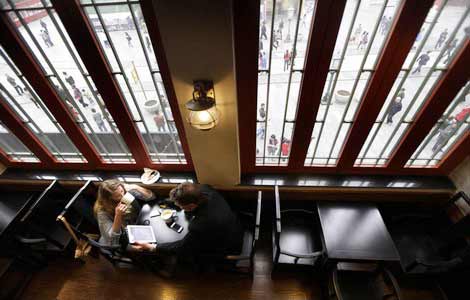 |
|
|
|
|||||||||||
|
 |
|
A woman drinks a cup of Starbucks coffee in a store at Qianmen Commercial Street in central Beijing, April 19, 2012. [Photo / Reuters] |
LOS ANGELES/BEIJING - Starbucks Corp has ambitious expansion plans in China, but like any big new emerging market there are teething problems, not least of which is that customers love it so much they stay for hours and hours and sometimes don't even buy a drink.
Chief executive Howard Schultz expects the Chinese mainland to overtake Canada as Starbucks' second-largest market by 2014 and some analysts believe it could one day rival the United States as the company's biggest market.
"The No 1 opportunity for the entire company is China," Schultz told about 300 Starbucks employees and their family members at a company forum in Beijing. "This is where we want to invest, where we want to grow."
Starbucks has reorganized decision-making to transfer more responsibility to its China unit from its headquarters in Seattle.
"We now have a design team here, a real estate team here," Schultz said. "We recognize that the size of the opportunity and the size of the prize in China is the most significant opportunity we have as a company."
The world's biggest coffee chain is a symbol of Western affluence in a nation of tea drinkers. But the tendency for Chinese visitors to linger in cafes and their lower income levels means sales volumes are much smaller than the United States and other markets where taking drinks to go is the norm.
"For a decade the core business was expats and tourists. Without question, the core business today is Chinese nationals," Schultz told Reuters ahead of his trip to Beijing and Shanghai where he is also meeting store managers.
Xu Baoli, a 51-year-old stock trader in Beijing, said he visits Starbucks at least 10 times a month, but doesn't go for the coffee. He is taking a break, surfing the Internet and meeting with clients.
Observers note that Chinese customers will sometimes bring their own food to Starbucks and Xu admits that every so often he doesn't bother to buy anything at all.
"I like the concept," said Xu. "Chinese people used to think you needed a spoon and saucer to drink coffee. Now, walking around with a Starbucks cup in your hand has become a fashion statement for Chinese."
With the US market maturing, few prizes are as enticing as China and its population of more than 1.3 billion.
Starbucks entered China in 1999 and now has more than 570 stores in 48 cities. By 2015, it plans more than 1,500 stores in 70-plus cities, though that would still only account for about half of China's major cities and would be just a fraction of the 10,800 stores in the United States.
"It could very well be exactly what's happening with Yum," Michael Yoshikami, chief executive of Destination Wealth Management, referring to KFC parent Yum Brands Inc. The US fast-food company got an early foothold in China and now gets more revenue from that market than any other.
And while Starbucks' China cafes contribute less than 5 percent of company revenue, their store operating profit margins, at around 22 percent, are higher than US cafes because they charge essentially US prices in a market famed for its low labor costs.